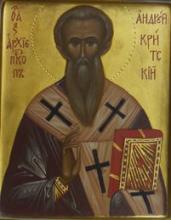4/17 July
 Hierarch Andrew was born in the city of Damascus, into a family of pious Christians. Until the age of seven years, the boy was dumb. Then, once, after partaking of the Holy Mysteries of Christ, he acquired the gift of speech and began to speak. From that time, the boy began to study Sacred Scripture and the theological sciences intensely.
Hierarch Andrew was born in the city of Damascus, into a family of pious Christians. Until the age of seven years, the boy was dumb. Then, once, after partaking of the Holy Mysteries of Christ, he acquired the gift of speech and began to speak. From that time, the boy began to study Sacred Scripture and the theological sciences intensely.
At fourteen years of age, he withdrew to Jerusalem and there received the tonsure in the monastery of Saint Sabbas the Sanctified. Saint Andrew led a strict, chaste life, was meek and abstinent, so that everyone was astonished at his virtues and understanding. As a man gifted and well known for his virtuous life, he, with the passage of time, was numbered among the Jerusalem clergy and appointed notarius the secretary of the Patriarchate. In the year 680, Theodore, the locum tenens of the Jerusalem Patriarchal cathedra, included Archdeacon Andrew among the representatives of the Holy City at the Sixth Ecumenical Council, where he struggled against heretical teachings, relying on his profound knowledge of Orthodox dogmas. Soon after the Council, he was recalled from Jerusalem to Constantinople and appointed archdeacon in the church of Hagia Sofia, the Holy Wisdom of God.
During the rule of the Emperor Justinian II (685-695), Saint Andrew was ordained as Archbishop of the city of Gortyna on the island of Crete. In this new arena, he began to shine like a true lamp of the Church, a great hierarchtheologian, a teacher and a hymnist. Hierarch Andrew wrote many liturgical hymns. He became the founder of a new liturgical form the canon. Of the canons composed by him, the Great Penitential Canon, which contains 250 troparia in its nine odes and is read in Great Lent, is the most well known. At Compline during the first week of Lent, it is read in sections (the so-called "methimoni") and in full at Matins on Thursday of the Fifth Week.
Hierarch Andrew of Crete glorified the Most Pure Virgin Mary with many praises. To him likewise belong: a canon for the Nativity of Christ, the threeode canons at Compline on Palm Sunday and on the first four days of Passion week, stichera for the Meeting of the Lord and many other hymns. Continuers of his hymnographical tradition were the great church hymnographers of the centuries that followed: Saints John Damascene, Cosmas of Miuma, Joseph the Hymnographer, Theophanes the Branded. Edifying discourses by Hierarch Andrew of Crete on certain church feasts have likewise been preserved.
Among Church historians, there is no single opinion concerning the time of the hierarch's end. Some designate the year 712, others 726. He died on the island of Militene, while returning to Crete from Constantinople, where he had been on Church matters. His relics were translated to Constantinople. In 1350, the pious Russian pilgrim, Stephen the Novgorodian, saw them in the Constantinopolitan monastery named after Saint Andrew of Crete.
